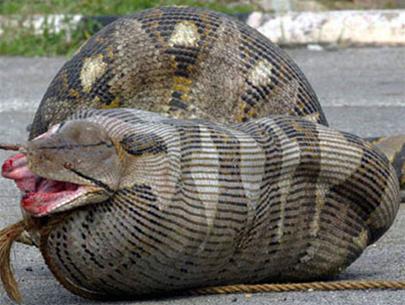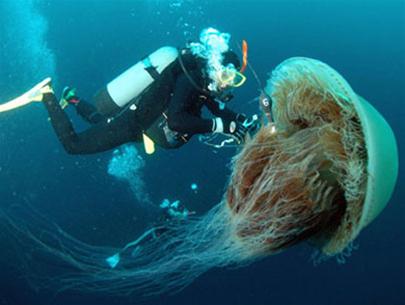10 most viewed scientific news in 2006
National Geographic has just published the 10 most widely read scientific news in 2006 of the magazine.
1. Python eating pregnant sheep .
A 5.5 meter long python swallowed the pregnant sheep. No matter how hungry the python should wait for the lamb to give birth. Because after eating all the sheep, the python could no longer move and needed a team of firefighters to leave the highway. However, after a while the python had to vomit the sheep. This is a rare phenomenon in nature. This phenomenon occurs when light passes through thin clouds.

2. Rare rainbow in Idaho
According to the London Daily Mail, this phenomenon has lasted for an hour with an area of several hundred square kilometers in the sky. Photo taken at the border between Washington DC and Idaho.

3. Giant jellyfish invaded Japan
Earlier this year, a large number of giant jellyfish went near the coast of Japan. These jellyfish can be up to 2 meters long and weigh up to 220 kg. In the picture is a divers following a giant jellyfish. This invasion has been utilized by scientists to study the migration habits and reproduction of this little-known animal.

4. The world is lost in Indonesia.
In the picture is a yellow-haired mammal, one of 12 new animal species found in Indonesia. Scientists say the golden fur is the marsupial animal that lives on the rarest tree in the world today. This is the first time that people have found yellow marsupials in Indonesia and so far they have only found them in two parts of the world.

5. House with glasses
Now, insects can also have their own collection of fashion glasses. The glass was used by scientists to build and wear the fly. This glass has a width of 2 mm. Micreon, which has produced this glass, says that with current technology, they can create objects with the same proportions and precision, but only by a thousandth of a millimeter.

6. The cat chases the bear on the tree
On a beautiful summer day, a black bear wandering in New Jersey encounters Jack, a 7 kg domestic cat has been removed. Surprisingly, the bear ran away and climbed a nearby cat. Jack chased the bear and stood under the tree without letting the bear climb down. 15 minutes later Jack was called into the house by the owner and there was a chance that the bear climbed down and ran into the forest.
It is known that cats are very respected animals while their bears are wandering foraging. Jack's owner said he hated having a strange animal entering its territory.

7. Discovering the pyramid in Bosnia?
Amateur archaeologist Semir Osmanagic found a proof that the four-sided hill in the town of Visoko is an artificial architecture. On April 19, Osmanagic and colleagues found carefully trimmed stones and they could be used to create the outer layer of an ancient pyramid ( small image ).

8. EveR-1 first appeared in Korea.
Korean scientists have created the female robot EveR-1 capable of talking and expressing some emotions of a normal human being. EveR-1 weighs 50 kg and is 160 cm tall when standing. EveR-1 can move the arms and hands but the lower half is completely motionless. Under her silicon skin, EveR-1 has 15 meters that allow her to express some emotions and is equipped with about 400 common words.

9. Pythons eat electric blankets.
The 3.5 meter long python originating from Myanmar is raised in Idaho, USA has eaten a large electric blanket. The wire of the blanket lies in the 2.5-meter digestive system of this 27-kilogram animal.
Houdini's owner (the name of the python) said he had left the electric blanket in the cage to warm it because the python was a cold-blooded animal. Houdini's owner also said that the blanket might have covered Houdini's rabbit, dinner, and it had swallowed the blanket.

10. The alien in the movie captures a duck.
Scientists working at the Center for Research and Avian Influenza in California were surprised to find a head baring their teeth for x-rays for a duck with a broken wing. The toothed head is in the duck's gizzard (in the right corner of the picture). Experts said that within 35 years of their work, they had never seen such a thing.
Experts do not know where they received such images. That explanation may be just grains in the duck's gizzard.

DKKL
- Synthesis of scientific news or the week of February 1
- Summary of the most viewed news of the week of September 3
- News aggregation or week 4/11
- Synthesis of scientific news or week 3/1
- 10 most viewed science pictures in 2005
- 10 most viewed scientific photos in 2012
- Summary of the best news of the week 05/4/2017
- Summary of the best news for the week of December 3
- Summary of the best news week 03/05/2017
- Best news aggregation for June 3
- Summary of the most viewed news week 01/10
- Best news aggregation week 03/05
 Vietnam 5th Asian champion on fuel-efficient vehicles
Vietnam 5th Asian champion on fuel-efficient vehicles We can read all NASA studies completely free of charge
We can read all NASA studies completely free of charge Singer and songwriter Bob Dylan won the 2016 Nobel Prize for Literature
Singer and songwriter Bob Dylan won the 2016 Nobel Prize for Literature Scientific revolution in Asia
Scientific revolution in Asia